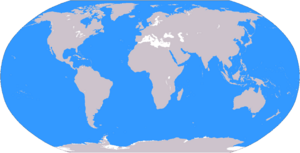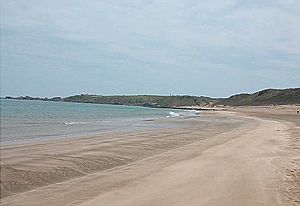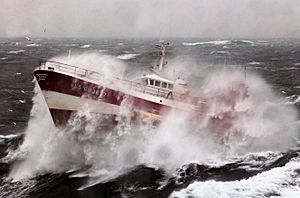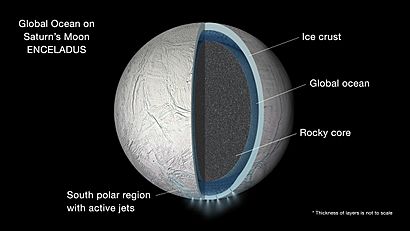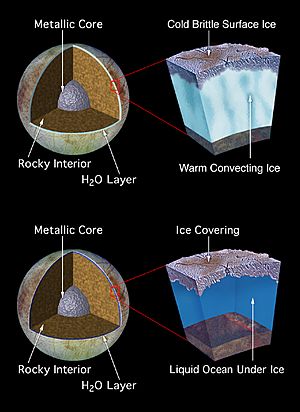Ocean facts for kids
An ocean is a huge area of salt water found between continents. Oceans are incredibly vast and connect many smaller seas. All the oceans on Earth are actually linked together, forming one giant "global ocean." These marine biomes cover about 72% of our planet's surface.
The Pacific Ocean is the largest ocean. It covers one-third of the Earth's surface! You can find many different kinds of sea creatures in the oceans. This includes various types of fish, crabs, starfish, sharks, and whales.
The Arctic Ocean is the smallest ocean. The Southern Ocean is also known as the Antarctic Ocean. It surrounds Antarctica. Strong water currents help separate it from the Atlantic, Pacific, and Indian Oceans. Some older maps might not show the Arctic Ocean and Southern Ocean by these names.
The Pacific Ocean is also the deepest ocean. Its deepest point is the Mariana Trench, which is about 11,000 meters (36,200 feet) deep. The very deep parts of the ocean are super cold, have high pressure, and are completely dark. Some amazing and unusual creatures live there. They get their energy from chemicals from inside the Earth, not from the sun.
Contents
Why Do Oceans Look Blue?
Many people think oceans are blue because they reflect the blue sky. But that's not quite right! Water itself has a very faint blue color. You can only see this color when there's a lot of water together.
The main reason oceans look blue or blue-green is how water handles light. Water absorbs the red parts of sunlight. It then reflects the green and blue parts of the light back. So, when we look at the ocean, we see the reflected blue and green light.
What Animals and Plants Live in the Ocean?
Ocean organisms are creatures that can live in salty water. Their lives are affected by sunlight, temperature, water pressure, and how the water moves. Different ocean animals and plants live near the surface, in shallow areas, or in very deep waters.
Small plant-like organisms called phytoplankton live near the surface. They use sunlight to make their own food. Almost all other ocean animals depend on these tiny plants for food, either directly or indirectly.
In shallow waters, you might spot lobsters and crabs. In deeper parts of the ocean, many different kinds of marine animals swim around. These include various fish like tuna and swordfish. You'll also find marine mammals such as dolphins and whales. Even large sea birds, like the albatross, live above the open ocean.
Life on Earth is thought to have started in the ocean. This means there's an incredible variety of life there! Here are some examples:
- Bacteria: These are tiny, single-celled organisms found everywhere in the ocean.
- Archaea: These are also single-celled organisms, but they are different from bacteria. They live in many ocean environments, including some very extreme places.
- Algae: This is a general term for many plant-like organisms that use sunlight to make food. Some are single-celled, like diatoms. Others are multicellular, like green algae, red algae (which includes edible seaweed like nori), and brown algae (like kelp).
- Plants: These include sea grasses and mangroves.
- Fungi: Many types of marine fungi play different roles in ocean environments.
- Animals: Most animal groups have species that live in the ocean. Some are only found in the sea, like sponges, corals, jellyfish, and sea urchins. Many other familiar animal groups mostly live in the ocean. These include cephalopods (like octopus and squid), crustaceans (like lobsters and crabs), fish, sharks, and cetaceans (like whales and dolphins).
Many land animals have also adapted to spend most of their lives in the ocean. For example, seabirds are a group of birds that live mainly on the oceans. They eat marine animals and spend most of their time on the water. Many only come to land to lay eggs. Other birds like penguins, seagulls, and pelicans also live in ocean areas. Seven types of sea turtles also spend most of their lives in the oceans.
How Do People Use the Ocean?
People use the ocean as a source of food, minerals, and energy. Countries like Russia and Japan have large ships that go to the best fishing spots for many months. These ships are like floating towns, with hospitals, schools, and repair shops for the fishermen and their families.
Fishing for Food
The FishBase.org website lists over 33,200 known types of fish. Many of these fish live in the oceans. A lot of these fish are a great source of protein for people to eat.
The fishing industry is very important. It provides jobs and food for millions of people around the world. Today, ocean fishing provides about 2% of the calories that people need.
Fish like Tuna, anchovies, and herring are caught near the ocean's surface. Other fish, such as Pollock, flounder, and cod, are caught closer to the ocean floor. Over a million tons of herring are caught each year in the North Pacific and North Atlantic. About eight out of ten of these fish are eaten by humans. The rest are used for things like fertilizer, glue, and food for pets and other animals.
What Are Ocean Temperatures Like?
Ocean temperatures vary a lot, both from the surface to the deep and across different parts of the world. Icebergs form in very cold waters near the Earth's poles. Meanwhile, waters near the equator are quite warm. Water heats up and cools down more slowly than land. This means that places near the ocean have milder seasons that start later than places far from the ocean.
The top part of the ocean, called the mixed layer, doesn't get much colder as you go a little deeper. Below this surface layer is a zone where the temperature changes suddenly. This is called a thermocline. It's a middle layer that goes from the surface down to about 800 meters (2,600 feet). Thermoclines can appear only during certain seasons or be there all the time. They also change depending on the location and depth.
When water evaporates, it cools down. If water evaporates very quickly, it becomes saltier. This salty, cold water is denser, so it sinks. This is why warm and cold waters don't mix easily. Most animals and plants live in the warm upper layer of the ocean. Below the thermocline, the deep ocean is extremely cold, just above freezing, between 0 and 3 degrees Celsius (32 and 37.4 degrees Fahrenheit).
Are There Oceans on Other Planets?
Earth is the only known planet in our Solar System with large, stable bodies of liquid water on its surface. However, scientists think that other celestial bodies might have big oceans too.
Oceans on Other Planets and Moons
The gas giants, Jupiter and Saturn, are thought to not have solid surfaces. Instead, they might have a layer of liquid hydrogen. We don't fully understand their planetary geology yet. The ice giants, Uranus and Neptune, might have hot, highly compressed, supercritical water under their thick atmospheres.
In 2006, a study suggested that Neptune probably doesn't have such a water "ocean." However, some studies have hinted that strange oceans of liquid diamond could exist there.
The Mars ocean hypothesis suggests that nearly one-third of Mars was once covered by water. Today, the water on Mars is mostly in its ice caps, not in oceans. Scientists are still studying this idea and trying to figure out why the water disappeared. Astronomers also believe that Venus might have had liquid water and even oceans very early in its history. If they did exist, they vanished later due to changes on the planet's surface.
Images for kids
-
The Atlantic, one part of the global ocean system, makes up 23% of it.
-
Map of large underwater features (1995, NOAA)
-
Ocean chlorophyll shows how much phytoplankton is present. Blue means less chlorophyll, red means more.
-
Map of the Gulf Stream, a big ocean current that moves heat from the equator to northern areas.
-
The ocean is a major part of Earth's water cycle.
-
How long elements stay in the ocean depends on how they enter (like from rock weathering and rivers) versus how they leave (like through evaporation and sedimentation).
See also
 In Spanish: Océano para niños
In Spanish: Océano para niños


